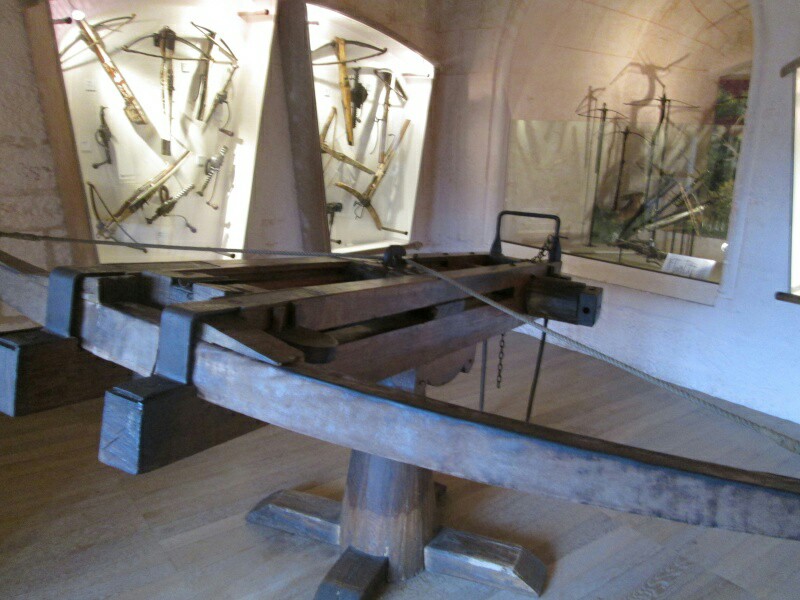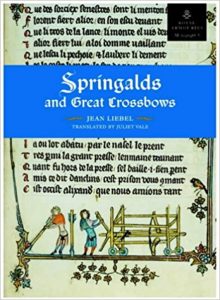Springalds and Great Crossbows

 Springalds and Great Crossbows – Jean Liebel (Translated by Juliet Vale)
Part of the Royal Armouries Monograph series
When I was sent this book to review, I was puzzled to know what a Springald was. Basically this book covers what we would now know as Artillery, but before the advent of gunpowder. So machines made from wood and ropes, levers and torsion. It is fascinating to have all this information on one book. The first thing that struck me in the book was that springalds and crossbows were different from other siege or artillery weapons in that they are low trajectory weapons, unlike their more popular cousins – the trebuchet or mangonel, which launched huge rocks high and far. Springalds were medieval period weaponry based on the Roman Ballistas.
But these were not just simply short range weapons, experiments in the book show that a springald could propel a large bolt over 160 metres. Springalds were usually gate mounted so they provided a powerful defence at the weakest point of a castle.
I have been to lots of castles but never seen a replica or mention of springalds during the early Middle Ages. Even the great Norman castles or Rochester and Dover don’t have them (although Dover does have a trebuchet). Think I might have to pay them a revisit. The book also shows paintings from the 14th century of wheel mounted springalds. Even Da Vinci seems to have got in on the act with springald designs.
A lot of the ports of the Hanseatic leagues appear to have had springalds both tower and gate mounted. I would imagine huge bolts would be quite damaging to ships if the need arose to use them.
The book covers some quite interesting design pictures. I wonder if any of the reenactment groups have these? I know some roman groups have ballista.
Here is a great YouTube video of a springald
From springalds, the book moves onto crossbows and not just small handheld crossbows, but two foot or windlass crossbows. Surviving examples of these crossbows have between 1.6 and 1.8 metres wide bows. Hardly something to be easily carried into battle.
In the 1200s, France seemed to have them and their spare repair parts in 15 towns across the kingdom. There is even mention of the papal palace in Avignon having two of them.
Again we see these become cart mounted, and even specialist bolts are used, including incendiary bolts…
The book then goes onto cover ballistics with lots of research and illustrations about effective ranges. For the period wargammer, the book provides a very useful resource for not only defensive siege equipment but provides charts and tables about ranges. If your ruleset doesn’t have springalds and great crossbows. They can now!
I can honestly say this was a fascinating read and I can wait o explore more castles now and look for signs of these weapons. If I had the space and technical ability I would love to make a springald.
If you are interested in the development of artillery or siege equipment, this book should be in your library of resources as it appears to be the only book of its kind of on the period.
Springalds and Great Crossbows – Jean Liebel (Translated by Juliet Vale)
Part of the Royal Armouries Monograph series
When I was sent this book to review, I was puzzled to know what a Springald was. Basically this book covers what we would now know as Artillery, but before the advent of gunpowder. So machines made from wood and ropes, levers and torsion. It is fascinating to have all this information on one book. The first thing that struck me in the book was that springalds and crossbows were different from other siege or artillery weapons in that they are low trajectory weapons, unlike their more popular cousins – the trebuchet or mangonel, which launched huge rocks high and far. Springalds were medieval period weaponry based on the Roman Ballistas.
But these were not just simply short range weapons, experiments in the book show that a springald could propel a large bolt over 160 metres. Springalds were usually gate mounted so they provided a powerful defence at the weakest point of a castle.
I have been to lots of castles but never seen a replica or mention of springalds during the early Middle Ages. Even the great Norman castles or Rochester and Dover don’t have them (although Dover does have a trebuchet). Think I might have to pay them a revisit. The book also shows paintings from the 14th century of wheel mounted springalds. Even Da Vinci seems to have got in on the act with springald designs.
A lot of the ports of the Hanseatic leagues appear to have had springalds both tower and gate mounted. I would imagine huge bolts would be quite damaging to ships if the need arose to use them.
The book covers some quite interesting design pictures. I wonder if any of the reenactment groups have these? I know some roman groups have ballista.
Here is a great YouTube video of a springald
From springalds, the book moves onto crossbows and not just small handheld crossbows, but two foot or windlass crossbows. Surviving examples of these crossbows have between 1.6 and 1.8 metres wide bows. Hardly something to be easily carried into battle.
In the 1200s, France seemed to have them and their spare repair parts in 15 towns across the kingdom. There is even mention of the papal palace in Avignon having two of them.
Again we see these become cart mounted, and even specialist bolts are used, including incendiary bolts…
The book then goes onto cover ballistics with lots of research and illustrations about effective ranges. For the period wargammer, the book provides a very useful resource for not only defensive siege equipment but provides charts and tables about ranges. If your ruleset doesn’t have springalds and great crossbows. They can now!
I can honestly say this was a fascinating read and I can wait o explore more castles now and look for signs of these weapons. If I had the space and technical ability I would love to make a springald.
If you are interested in the development of artillery or siege equipment, this book should be in your library of resources as it appears to be the only book of its kind of on the period.
You can buy this book on Amazon. You can also pick it up direct from Pen and Sword Books.
Please note I was not paid to write this review but was sent a review copy of the book. All comments are my own, and the publishers have not amended the review in any way.
< BACK